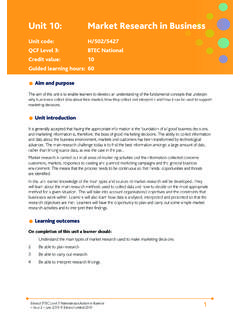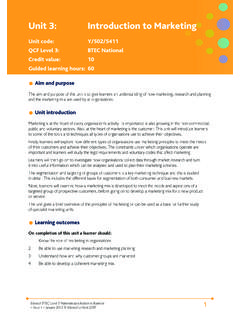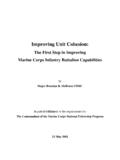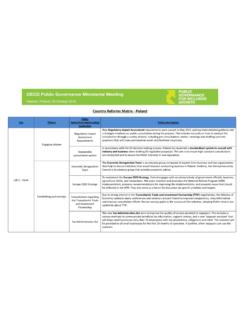Transcription of Unit 3: Introduction to Marketing
1 1 Edexcel BTEC Level 3 Nationals specification in Business Issue 1 January 2010 Edexcel Limited 2009 unit 3: Introduction to MarketingUnit code: Y/502/5411 QCF Level 3: BTEC NationalCredit value: 10 Guided learning hours: 60 Aim and purposeThe aim and purpose of this unit is to give learners an understanding of how Marketing , research and planning and the Marketing mix are used by all introductionMarketing is at the heart of every organisation s activity. Its importance is also growing in the non-commercial, public and voluntary sectors. Also, at the heart of Marketing is the customer. This unit will introduce learners to some of the tools and techniques all types of organisations use to achieve their , learners will explore how different types of organisations use Marketing principles to meet the needs of their customers and achieve their objectives.
2 The constraints under which organisations operate are important and learners will study the legal requirements and voluntary codes that affect will then go on to investigate how organisations collect data through market research and turn it into useful information which can be analysed and used to plan their Marketing segmentation and targeting of groups of customers is a key Marketing technique and this is studied in detail. This includes the different bases for segmentation of both consumer and business markets. Next, learners will examine how a Marketing mix is developed to meet the needs and aspirations of a targeted group of prospective customers, before going on to develop a Marketing mix for a new product or unit gives a brief overview of the principles of Marketing or can be used as a basis for further study of specialist Marketing outcomesOn completion of this unit a learner should.
3 1 Know the role of Marketing in organisations2 Be able to use Marketing research and Marketing planning3 Understand how and why customer groups are marketed4 Be able to develop a coherent Marketing BTEC Level 3 Nationals specification in Business Issue 1 January 2010 Edexcel Limited 20092 unit content1 Know the role of Marketing in organisationsRole: overall concept; Marketing definitionsObjectives: private sector aims and objectives (survival, growth); public and voluntary sector aims and objectives (service provision, growth of range of provision, cost limitation, meeting quality standards); Marketing objectives, eg market leadership, brand awareness, perceptions of customers or users; link between organisational objectives and Marketing objectives Techniques: growth strategies (diversification, product development, market penetration or market development, Ansoff s Matrix); survival strategies; branding (importance in influencing buyer behaviour, brand building, positioning, brand extension).
4 Relationship Marketing (definition, difference between transactional Marketing and relationship Marketing , value of lifetime customer)Limitations and constraints: legal (Sale of Goods Act 1979, The Consumer Protection from Unfair Trading Regulations 2008, Consumer Credit Acts 1974 and 2006, Consumer Protection (Distance Selling) Regulations, Data Protection Act 1998); voluntary, eg Code of Advertising Practice and Advertising Standards Authority; pressure groups and consumerism; acceptable language 2 Be able to use Marketing research and Marketing planningMarketing research: qualitative; quantitative; primary internal/external research; secondary internal/external research; uses (reduce risk in decision making, measure progress over time); limitations (cost effectiveness, validity of data collected) Marketing planning: Marketing planning process model (audit with PESTLE (political, economic, social, technological, legal and environmental external factors); SWOT (internal strengths and weaknesses, external opportunities and threats); set SMART (specific, measurable, achievable, resourced, time-bound) objectives; determine strategy and tactics, implement changes.)
5 Evaluate)3 Understand how and why customer groups are targetedIdentifying customers in consumer markets: difference between customers, consumers and buyers; importance of identifying who has influence over purchasing decisionsMarket segmentation: importance; bases for segmentation of consumer markets (geographic, demographic, psychographic, lifestyle); uses of geo-demographic systems to identify and reach target groups eg ACORN, MOSAIC; reasons for choice of target group (accessibility, current and future prospects of group as customers, profitability; ability to service customer group, fit with organisation s mission) Identifying customers in business to business markets: decision making unit (DMU)Market segmentation: bases for segmentation of business markets (size, region, value, public/private/voluntary sector, product, industry); benefits for different members of the DMU, eg cost benefits, ongoing relationships, security of supply3 Edexcel BTEC Level 3 Nationals specification in Business Issue 1 January 2010 Edexcel Limited 20094 Be able to develop a coherent Marketing mixMarketing mix: 4 P s product; price; place; promotion.
6 Objectives of developing mix (support brand building, satisfy needs and aspirations of targeted group of customers); importance of need for cohesion of different elements of the Marketing mixProduct: product range; benefits versus features of product or service for targeted customers; concept of product life cyclePrice: pricing strategies (premium pricing, penetration pricing, economy pricing, price skimming, psychological pricing, captive product pricing, product line pricing)Place: distribution; online and/or physical presencePromotion: promotional mix (advertising (different media, online techniques), personal selling, public relations, sales promotion)Edexcel BTEC Level 3 Nationals specification in Business Issue 1 January 2010 Edexcel Limited 20094 Assessment and grading criteria In order to pass this unit , the evidence that the learner presents for assessment needs to demonstrate that they can meet all the learning outcomes for the unit .
7 The assessment criteria for a pass grade describe the level of achievement required to pass this and grading criteriaTo achieve a pass grade the evidence must show that the learner is able to:To achieve a merit grade the evidence must show that, in addition to the pass criteria, the learner is able to:To achieve a distinction grade the evidence must show that, in addition to the pass and merit criteria, the learner is able to:P1 describe how Marketing techniques are used to market products in two organisations[IE] M1 compare Marketing techniques used in Marketing products in two organisationsD1 evaluate the effectiveness of the use of techniques in Marketing products in one organisationP2 describe the limitations and constraints of Marketing [RL]
8 P3 describe how a selected organisation uses Marketing research to contribute to the development of its Marketing plansM2 explain the limitations of Marketing research used to contribute to the development of a selected organisation s Marketing plansD2 make justified recommendations for improving the validity of the Marketing research used to contribute to the development of a selected organisation s Marketing plansP4 use Marketing research for Marketing planningP5 explain how and why groups of customers are targeted for selected productsP6 develop a coherent Marketing mix for a new product or service.[CT]M3 develop a coherent Marketing mix that is targeted at a defined group of potential : This summary references where applicable, in the square brackets, the elements of the personal, learning and thinking skills applicable in the pass criteria.
9 It identifies opportunities for learners to demonstrate effective application of the referenced elements of the independent enquirersCT creative thinkersRL reflective learners TW team workersSM self-managersEP effective participators5 Edexcel BTEC Level 3 Nationals specification in Business Issue 1 January 2010 Edexcel Limited 2009 Essential guidance for tutorsDeliveryFor learning outcome 1, it is important to address the assumption many learners may have that Marketing is merely advertising. In fact, it is a more complex activity and this unit gives a deeper understanding of the whole Marketing process. The business purposes and strategic planning covered in the unit : The Business Environment, may be revisited to show the links and differences between organisational and Marketing objectives.
10 Next, learners move on to an overview of key Marketing principles. Learners could apply Ansoff s matrix to a simple case study, an organisation they are familiar with, or to a business game. Branding and relationship Marketing provide opportunities for linking with learners existing knowledge as consumers. Learners move onto the legislation which constrains marketers. The principles of the legislation should be covered and then applied to situations which may be familiar to learners as outcome 2 includes an Introduction to Marketing research, and learners may enjoy conducting their own research. However, if there is insufficient time for this, an exercise where learners plan research to meet specified needs could be used to consolidate the teaching.










